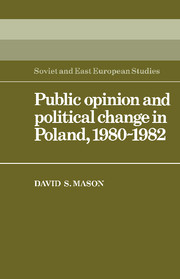Book contents
- Frontmatter
- Contents
- List of tables
- Preface
- Introduction: public opinion and politics
- 1 Public opinion research in Poland
- 2 The public and policy change in the 1970s
- 3 Values of Polish society on the eve of August
- 4 1980: causes and results
- 5 The rise and fall of Solidarity
- 6 The Party and ‘renewal’
- 7 Solidarity and the regime at the end of 1981
- 8 Martial law as a response and the response to martial law
- 9 Conclusions
- Appendix
- References
- Index
Introduction: public opinion and politics
Published online by Cambridge University Press: 05 February 2012
- Frontmatter
- Contents
- List of tables
- Preface
- Introduction: public opinion and politics
- 1 Public opinion research in Poland
- 2 The public and policy change in the 1970s
- 3 Values of Polish society on the eve of August
- 4 1980: causes and results
- 5 The rise and fall of Solidarity
- 6 The Party and ‘renewal’
- 7 Solidarity and the regime at the end of 1981
- 8 Martial law as a response and the response to martial law
- 9 Conclusions
- Appendix
- References
- Index
Summary
Some fifteen years ago, Herbert McClosky (1969, p. 10) called for more rigorous research techniques in the study of politics. He suggested that public opinion data could help balance traditional political and historical studies, which would often ‘infer a nation's climate of opinion from a relatively small number of books, articles, speeches, editorials, or legislative acts’. ‘When one observes political phenomena anecdotally’, he wrote, ‘one's eye is drawn to whatever is dramatic and exciting, which means, often, to whatever is idiosyncratic and atypical.’ Systematic use of public opinion data could help provide a more accurate view of a nation's climate of opinion.
Since that time, such techniques have become commonplace in the study of politics in Western societies and have added a great deal to our understanding of political processes in general. Studies of politics in communist societies, however, are still mostly in the traditional mode, in spite of numerous efforts to apply more rigorous social-science methods in this area (e.g. Fleron 1969). To a large extent, the problem is due to the lack of available and reliable data from these countries; this has been the case especially with public opinion data. In recent years, such data from Eastern Europe and the Soviet Union have become somewhat more available. Poland has been the most advanced country in the region in conducting and publishing such research, and the Solidarity era stimulated a flood of open and provocative public-opinion surveys.
- Type
- Chapter
- Information
- Publisher: Cambridge University PressPrint publication year: 1985



